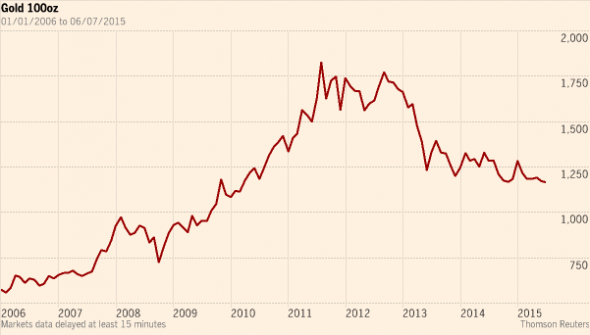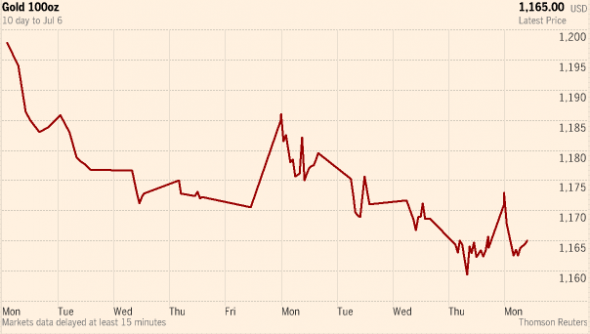FTAV in general, and Izabella Kaminska in particular, have been more accurate on investor appetite for gold than people who are paid big money-cough-BlackRock's Evy Hambro-cough-to figure this, and only this, stuff out.
The failure of gold to do much of anything when Greeks were lining up at the banks before the referendum was actually brought to my attention and I actually thought about posting something before getting distracted by some incipient disaster or other. So here's Izzy on the dog that didn't bark:
August gold $1164 down $9.20.
From FT Alphaville:
A not very golden crisis
Here’s a puzzle. Neither the Chinese stock slide or the Greek ‘no’ vote are having much of an effect on the gold price — odd given that the goldbug narrative that gold always performs well in a crisis:
In fact, looking at the 10-day performance, the trend is distinctly to the down side:
What gives?And the response, from Harper's Magazine, gold can be pretty:
Barclays’ Suki Cooper has an interesting view (our emphasis):
The failure of gold to appreciate given global macroeconomic uncertainty (Figure 2) may seem puzzling initially but is explainable. Over the past few weeks, as the Greek crisis reached a climax, gold prices failed to appreciate in any meaningful way, continuing their downward trend since crossing $1,300/oz in late January. The market has assessed that the risk of contagion from a Greek default is limited, more contained than in 2011 when Greece was last in the headlines.
There is another reason gold has failed to gain ground: in our view, the dominant issue for the gold price this year has been the prospect of a US Federal Reserve rate hike....MORE
July 6, 2015, 2:25 pm
Tree, South of France

“Tree, South of France,” photograph printed on glass with gold leaf, from the series Au, by Kate Breakey. The series was inspired by a theory according to which gold (Au) was produced by the collision of neutron stars. As Breakey describes the theory:
The events that produce most of the gold in the universe are called gamma-ray bursts. These occur when two neutron stars, the cores of dead stars, collide under the force of gravity. Neutron stars are as dense as atomic nuclei: though they are only a few miles in diameter they have more mass than the Sun. A pair of dead, dark neutron stars will spin around each other for millions of years at millions of miles per hour, slowly but constantly pulling each other closer. In the moment that they finally they touch, they release more gamma-ray energy than exists in the rest of the universe. Much of their mass collapses into a black hole, but the remainder produces an enormous explosion of gamma rays and newly formed elements, including gold. Some of that stardust joined with other elements to form Earth’s core; other quantities were deposited in the Earth’s crust by asteroids that arrived 3.8 billion years ago, during the so-called Late Heavy Bombardment. The Ancient Egyptians believed that gold was the flesh of their Sun god, Ra....

